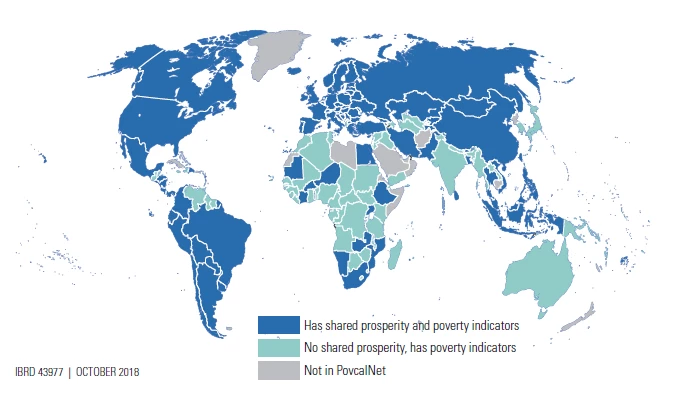Shared prosperity is one of the World Bank Group’s Twin Goals, introduced in 2013. Progress toward this goal is monitored through an indicator that measures the annualized growth rate in average household per capita income or consumption among the poorest 40 percent of the population in each country (the bottom 40), where the bottom 40 are determined by their rank in household per capita income or consumption. Chapter 2 of the 2018 Poverty & Shared Prosperity Report provides an update on the recent mixed progress on shared prosperity around the world in about 2010-15.
The shared prosperity indicator was proposed as a means to shine a constant light on the poorest segments of the population in every country, irrespective of their level of development. Shared prosperity has no target or finish line, because the aim is to continuously improve well-being. In good times and in bad, in low and high-income economies alike, the bottom 40 percent of the population in each nation would be monitored. Tracking the bottom 40’s absolute growth as well as their growth relative to the mean is a way to remind us to always consider distributional impacts and strive for equitable outcomes.
An important but challenging goal to monitor
Despite its importance and universal relevance, shared prosperity is more challenging to monitor than global poverty. While one household survey is sufficient to calculate poverty, shared prosperity measurement requires two recent comparable surveys.
The implication of this stronger data requirement is that 91 out of the 164 economies with an international poverty rate measured in PovcalNet are included in the 6th edition of the Global Database of Shared Prosperity (GDSP).
Data frequency is the biggest challenge to measuring shared prosperity
The data requirements for shared prosperity can be cascaded into three interlinked factors, which also helps to understand which requirements are the most restrictive.
- Recent – at least one survey since 2008
- Frequent – at least two surveys since 2008 and conducted near 2010 and 2015
- Comparable – two surveys must be comparable
| Number of countries represented in PovcalNet | 164 |
|---|---|
| Recent: with at least one survey from 2008 and onwards | 151 |
| and Frequent: with at least two surveys | 101 |
| and Comparable: consistent methodology | 91 |
The main constraint is frequency. Most countries in PovcalNet have a recent household survey after 2008, only 10 do not. However, among these, 50 do not have at least two household surveys that are recent. Among countries with at least two recent household surveys, most are comparable.
Often shared prosperity cannot be measured where we need to understand it the most
International Development Association (IDA) countries, small states, fragile and conflict-affected situations (FCS), and those experiencing crisis are less likely to have sufficient survey data to calculate shared prosperity. This is because household survey collection is costly and requires a certain level of statistical capacity. Many small Pacific island economies rely on international donor support to fund and implement household survey data collection. In conflict situations, unsurprisingly, survey collection can be too dangerous to be conducted regularly. Out of the 75 IDA economies, 24 have never had a shared prosperity indicator measured by the World Bank since monitoring began in 2014.
Among the 164 economies with international poverty measures, 57 economies have a poverty rate higher than 10 percent in the 2015 global line-up. Of these, only 13 have a shared prosperity indicator. Given our desire to reduce poverty for all individuals in all economies, it is unacceptable that we do not know how the bottom 40 are faring in some of the economies where it is the most essential.
The coverage of the shared prosperity indicator varies also by region, although progress has been made. A number of economies have never had a shared prosperity indicator calculated since the GDSP was first released in 2014 based on surveys around 2007 and 2012. Until this edition, the Middle East & North Africa region had a large concentration of economies without this indicator.
East Asia & Pacific appears to have adequate data on shared property by population coverage, but this region lacks sufficient country coverage. Many of economies lacking a current shared prosperity estimate are small island economies, although some large economies, such as Papua New Guinea, Myanmar, and Cambodia, are also lacking the recent, frequent, and comparable data needed.
In Sub-Saharan Africa, where the proportion of economies included in the sixth GDSP is low, most economies have had a shared prosperity indicator published at least once since its inception. In other words, surveys are being conducted in most African economies, but just not with sufficient frequency.
Progress is being made on data collection
One should not be discouraged by the challenges in coverage, indeed, shared prosperity is still relevant and incredibly informative. Knowing where household consumption is increasing or shrinking, and where it cannot be measured at all still contributes to the dialogue, stressing the relevance of the data agenda.
Despite these challenges, our ability to monitor shared prosperity is improving. Conscious efforts to reduce data deprivations will continue to improve the coverage of the shared prosperity indicator in the years to come. In 2016, the WBG started an initiative in IDA countries to complete household surveys every 3 years to narrow data deprivation. And in fact, the number of countries where shared prosperity can be measured has increased: In the previous 2016 Poverty & Shared Prosperity report, shared prosperity was calculated for 83 economies, compared to 91 economies today.
To learn more about shared prosperity, read the recently released Poverty and Shared Prosperity report 2018, “Piecing Together the Poverty Puzzle.”




Join the Conversation